If you’ve ever dreamed of venturing beyond the beautiful but familiar landscapes of Scotland’s mainland, you’re in for a treat. The Orkney Islands, a cluster of over 70 islands perched at the north edge of the Scottish mainland, are a different world. It’s a place where you can experience history, the beauty of nature, and vibrant communities.
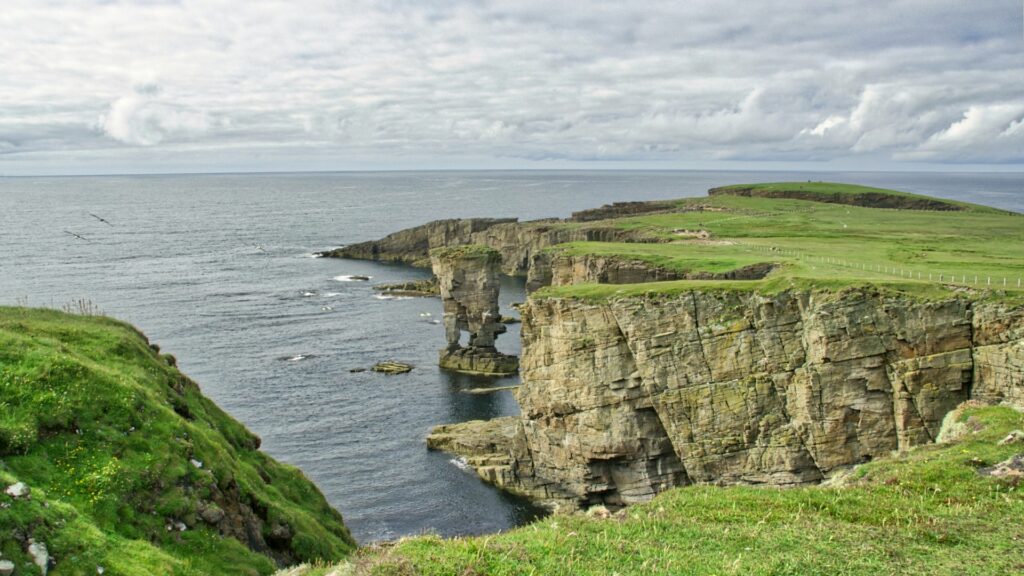
More similar in culture and history to Norway than to the United Kingdom they’re currently part of, the islands were ruled by Norway for over 600 years. That means there’s a distinctly Viking history, as well as a deep neolithic history visible throughout the islands.
You can almost hear the echoes of Neolithic footsteps at the megalithic stone circle of Skara Brae, and the Norse sagas still shape the islands’ names and folklore.
Disclosure: This post may contain affiliate links, meaning I may get a small commission if you decide to make a purchase through my links, at no cost to you.
The Orkney Islands at a Glance
The Orkney Islands sit off of Scotland’s north coast between Scotland and Norway, surrounded by the North Sea.
How to get to the Orkney Islands
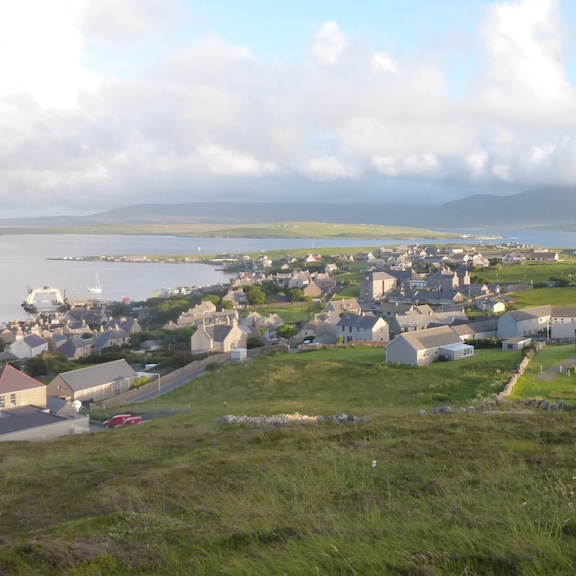
Orkney is more accessible than you might think. Whether you’re a fan of scenic ferry rides that glide past breathtaking coastlines or prefer a quick flight, getting to Orkney isn’t difficult.
NorthLink Ferries travel between Aberdeen and Kirkwall up to four times per week on their way to and from the Shetland Islands. The trip is fairly long, between 6-8 hours each way.
For a shorter trip NorthLink also has a ferry that runs multiple times daily between Scrabster, on the Scottish mainland, and Stromness. The trip is only 90 minutes, and you’ll be able to see the beautiful Old Man of Hoy, one of the natural wonders of the Orkney Islands.
Once you’ve arrived at the Orkney mainland you can travel to several of the other islands with Orkney Ferries.
You can also fly to Kirkwall, the Orkney Island capital, from Edinburgh, Glasgow, Aberdeen and Inverness on the mainland or to some of the outlying islands.
If you’re interested in taking the world’s shortest scheduled commercial flight, you’ll find it operated by Logan Air traveling between Westray and Papa Westray. It makes a great day trip just to say you’ve done it!
For a full escorted tour, this is the 5-day Orkney Island tour I recommend to my clients.
Best times to visit the Orkney Islands
The Orkney Islands are open for business year-round, but if you’re looking for the sweet spot, aim for May through September.
These months serve up longer days, allowing the sun to cast its golden glow over the ancient stones and vibrant fields. The summer solstice, in particular, is a time of magic, where the midnight sun hovers at the edge the sky and sea.
Weather in the Orkney Islands
Scottish weather can be unpredictable in the best of times. In Orkney the climate takes a cue from the surrounding seas, sometimes offering all four seasons in a single day.
Mild winters and cool summers are the norms. I visited in the middle of August, and it was considered a warm day with the high around 70 Farenheit.
The wind is also something to consider. The Orkney Islands are nearly devoid of trees due to the strong winds that blow across them. They not only sculpt the landscape, they’ll sculpt your hairstyle too!
Kirkwall: The heart of Orkney
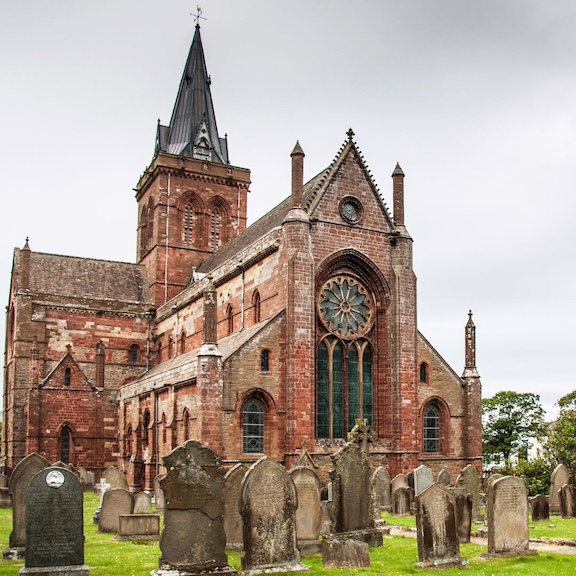
Kirkwall, the vibrant capital of the Orkney Islands, stands as a gateway to the archipelago’s ancient history and lively contemporary culture.
Discover Kirkwall: Plan a trip to Scotland’s hidden gem
With its charming blend of medieval heritage and modern life, Kirkwall is not just a stopover but a destination in its own right, offering a glimpse into the culture and traditions of the islands.
Where to stay in Kirkwall
The Kirkwall Hotel: The Kirkwall Hotel is a historic gem on Harbour Street, offering picturesque views of the boats sailing by.
Established in the 19th century, the hotel exudes old-world charm, from its Victorian architecture to its antique-filled interiors. While the building may be historic, the amenities are up-to-date, ensuring a comfortable stay.
The hotel’s restaurant is a local favorite, known for its seafood specialties and classic Scottish fare. If you want to stay in the heart of Kirkwall with a touch of historic elegance, The Kirkwall Hotel is the place to be.
Ayre Hotel: The Ayre Hotel is a family-run establishment that prides itself on warm hospitality and personalized service. The hotel is near Kirkwall Harbour and offers easy access to local attractions.
The rooms are spacious and well-appointed, providing a comfortable base for your Kirkwall adventures. The on-site restaurant serves up traditional Orkney dishes with a contemporary twist. With its friendly atmosphere and convenient location, Ayre Hotel is a solid choice for exploring Kirkwall and beyond.
Things to do in Kirkwall
St. Magnus Cathedral: Dominating the Kirkwall skyline, this magnificent red sandstone cathedral, founded in 1137, is a masterpiece of Norse architecture. Its rich history and stunning craftsmanship make it a must-visit.
Earl’s and Bishop’s Palaces: These imposing ruins tell tales of Orkney’s past grandeur and intrigue. Exploring these palaces offers a glimpse into the island’s medieval history and its strategic importance.
Orkney Museum: Housed in one of Kirkwall’s oldest buildings, the Orkney Museum takes you on a journey through time, from prehistoric Orkney to the present day, showcasing the islands’ heritage and culture.
Kirkwall is a vibrant town rich with history, culture, and the spirit of the islands. Whether you’re wandering through the ancient streets, savoring local flavors, or setting sail to the surrounding isles, Kirkwall offers a taste of Orkney’s magic, making it an essential part of your journey.
Stepping back in time: The heart of Neolithic Orkney
The Orkney Islands are home to four major Neolithic sites, together listed as the Heart of Neolithic Orkney UNESCO World Heritage Site. Each of these Neolithic sites are left from a civilization that thrived over 5,000 years ago.
They are all located on the Orkney Mainland, the largest island in the Orkney archipelago, and are easily accessible from Kirkwall.
Skara Brae

Nestled on the windswept shores of the Bay of Skaill, Skara Brae is Europe’s most complete Neolithic village. Discovered beneath a sand dune in 1850, this prehistoric marvel reveals the intricacies of life in 3180 BCE. Each stone-built house, interconnected by covered passageways, tells a story of ingenuity and survival.
Getting There: From Kirkwall, a scenic drive of about 30 minutes will take you to Skara Brae. If you’re venturing from mainland Scotland, ferries to Orkney typically arrive in Stromness, a short 20-minute journey from Skara Brae.
The Ring of Brodgar
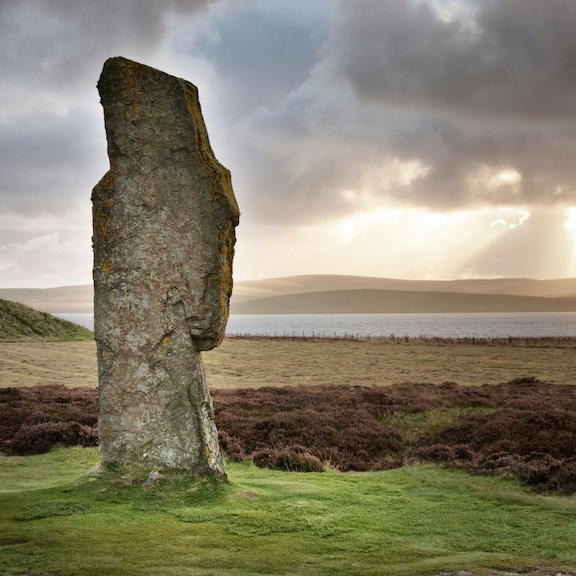
The Ring of Brodgar is a colossal stone circle older than Stonehenge, is majestically poised between the Lochs of Stenness and Harray.
This enigmatic monument, dating back to around 2500-2000 BCE, features a vast ceremonial circle surrounded by a rock-cut ditch. The purpose remains a mystery, but its magnetic allure is undeniable.
Getting There: A 15-minute drive from Kirkwall or Stromness will get you to the Ring of Brodgar.
The Stones of Stenness
Even older than the Ring of Brodgar, the Stones of Stenness are one of the oldest stone circles in the British Isles. Dating to around 3100 BCE, the ancient circle is testament to Orkney’s deep-rooted ceremonial past.
Getting There: Situated just a stone’s throw from the Ring of Brodgar, the Stones of Stenness are easily accessible from Kirkwall or Stromness in about 10 minutes.
Maeshowe
Maeshowe is an architectural masterpiece of Neolithic tomb construction and stands as a testament to the ingenuity of Orkney’s ancient inhabitants.
This grand, chambered cairn, built around 2800 BCE, is especially popular to visit at the winter solstice. That’s when the setting sun will align perfectly with the entrance passage, illuminating the inner chamber.
Getting There: Maeshowe is about 15 minutes from both Kirkwall and Stromness.
The natural beauty of the Orkney Isles
Orkney is about more than Neolithic monuments. It’s also a paradise for nature lovers.
Its landscapes, carved by the elements over millennia, offer a spectacular array of natural beauty. From towering sea stacks to serene coastlines, you won’t run out of things to see.
The Old Man of Hoy
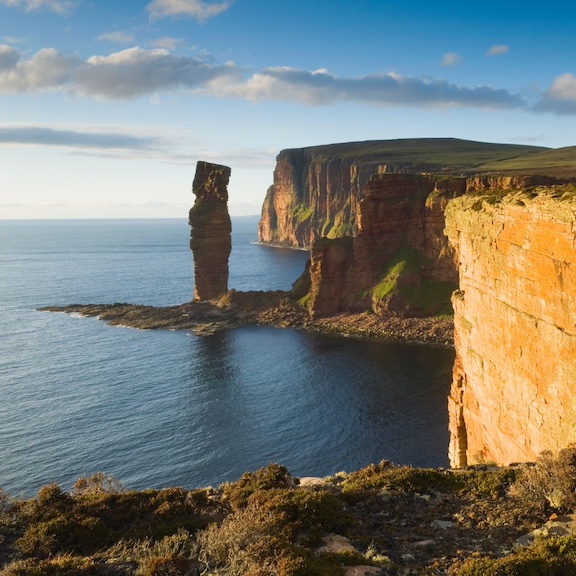
The Old Man of Hoy, a towering sea stack sculpted by the relentless North Sea, stands as a majestic sentinel on the island of Hoy. This 450-foot tall red sandstone giant especially popular with climbers and birdwatchers.
Getting There: Hoy is a short ferry ride from Stromness on the Orkney Mainland. Once on Hoy, you can hike to the Old Man, which offers breathtaking views and an invigorating Orkney air experience.
Yesnaby
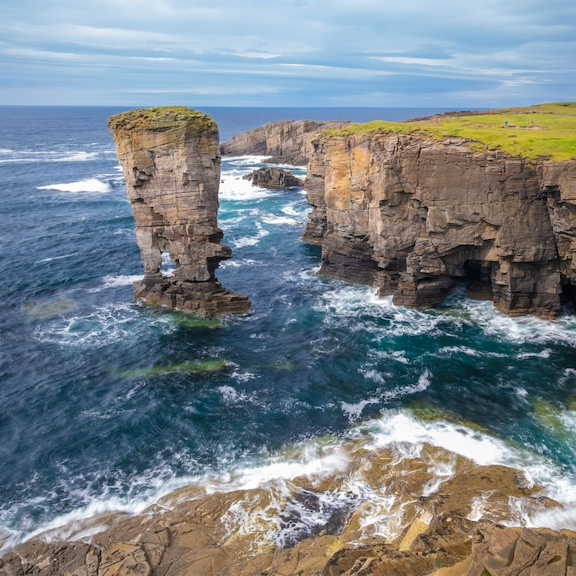
Located on the west coast of Orkney’s Mainland, Yesnaby is known for its dramatic cliffs, rare plant life, and the iconic Yesnaby Castle sea stack.
The area’s rugged beauty, with waves crashing against the cliffs, offers some of the most spectacular coastal walks in Orkney, where every turn reveals a new vista.
Getting There: Yesnaby is easily accessible by car from Kirkwall in about 25 minutes. The route offers scenic views and a chance to immerse yourself in the tranquility of Orkney’s landscapes.
The Brough of Birsay
The tidal island on the northwest tip of the Orkney Mainland is rich in both Viking and Pictish history. However, it’s the island’s natural beauty, with its diverse birdlife, tidal pools, and rugged coastline, that captures the imagination.
Access to the island is an adventure in itself, governed by the rhythm of the tides. The causeway is only accessible for about 2 hours on either side of low tide, so you’ll want to time your visit accordingly so you aren’t stuck on the island until the tide goes back out.
Getting There: A 30-minute drive from Kirkwall brings you to the Birsay mainland, with the causeway to the island accessible at low tide.
The Italian Chapel
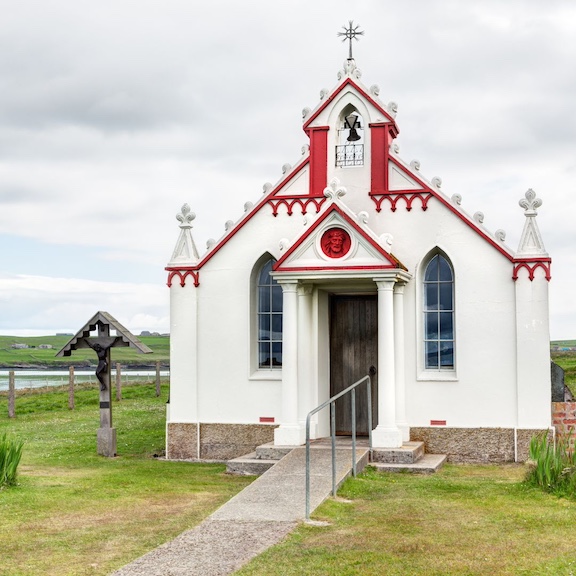
While not a natural wonder, the Italian Chapel, on the small island of Lamb Holm, is a testament to the human spirit’s resilience and creativity. This beautiful chapel, crafted from a Nissen hut by Italian prisoners of war transported to the islands to construct the Churchill Barrier during World War II.
Its intricate interior, a stark contrast to the sparse landscape outside, tells a poignant story of hope and beauty in the face of adversity.
Getting There: Lamb Holm is connected to the Orkney Mainland by the Churchill Barriers, making the Italian Chapel easily accessible by car from Kirkwall in just about 15 minutes. The Churchill Barriers also provide access to the islands of Glimps Holm, Burray and South Ronaldsay
Island Hopping: Exploring Beyond Mainland Orkney
Each Orkney island has its own character and tales to discover. Ferries connect many of the islands, making exploration both easy and scenic.
Hoy: The “high island”

Hoy, known by the Vikings as “high island,” is the second largest island in the archipelago.
Best known for its dramatic cliffs and the famous Old Man of Hoy, it’s a haven for adventurers. The rugged landscape is a stark contrast to the rolling greenery of the Mainland, with mountainous terrains and sweeping glens.
The Dwarfie Stane, a Neolithic tomb carved into a massive rock, adds a touch of mystery to the island’s allure.
Getting There: You can reach Hoy by taking Orkney Ferries from Stromness. Although the island has a population of only around 400 people, there are a few very small, family run hotels as well as cottages for rent if you’d like to stay for a few days.
Rousay: The Egypt of the North
Rousay is a treasure trove of more than 150 ancient archaeological sites, with its nickname, “The Egypt of the North,” hinting at the wealth of historical wonders waiting to be explored. From the Midhowe Broch to the Taversoe Tuick burial cairn, Rousay offers a journey back in time, set against a backdrop of breathtaking views.
Getting There: A short ferry ride from Tingwall on the Mainland will transport you to this Rousay, home to about 200 people.
There is a local pub and a shop as well as a couple of rental properties if you’d like to spend a few nights on the island. You can also visit the neighboring islands of Egilsay and Wyre. These islands are both excellent walking destinations, but don’t have any public services so you’ll need to bring food and drinks with you.
Westray: The Queen of the Isles
Westray, affectionately known as the “Queen of the Isles,” is a microcosm of all that Orkney has to offer – rich history, vibrant community, and stunning landscapes.
The Noltland Castle archaeological site offers glimpses into the island’s storied past, while the puffin colonies at Castle o’ Burrian are a delight for wildlife enthusiasts.
Getting There: Hop on a ferry from Kirkwall to Westray or fly from Kirkwall to the tiny Westray airport. From there you can board the world’s shortest commercial flight (about a minute of flight time) to Papa Westray.
There are a few lodging and food options on Westray, and the island is home to multiple local shops, pubs and restaurants.
Planning Your Orkney Islands Adventure: Practical Tips
Island hopping in Orkney is an adventure that calls for a bit of planning. Here are some tips to make your exploration as smooth as the island whisky:
- Check Ferry Schedules: Orkney’s lifelines, the ferries, run on schedules that can change with the seasons. Always check the latest timetables to ensure you know when you need to be at the ferry terminal. If you’re traveling with a vehicle, make sure to book the vehicle space in advance since the ferries do fill up.
- Embrace Island Time: In Orkney, time has a different rhythm. Allow for flexibility in your plans to accommodate weather changes or the spontaneous decision to linger a little longer in a place that captures your heart.
- Pack Wisely: Orkney’s weather can be unpredictable. Layer up and include waterproof gear. And don’t forget your binoculars for birdwatching and your camera to capture the endless moments of beauty.
- Respect the Environment: These islands are both beautiful and fragile. Follow the “Leave no trace” principles, leaving nothing behind that you brought and taking nothing with you that you didn’t bring.
The bottom line: Visiting the Orkney Islands
Orkney is full of adventures, stories and landscapes to be experienced. If you’re considering a new destination, someplace you’ve never been or maybe even heard of, I highly recommend planning a visit.
Contact us today to start planning your trip to the Orkney Islands. For more Scotland travel inspiration, check out our other Scotland travel blog posts here.
If you’ve ever dreamed of venturing beyond the beautiful but familiar landscapes of Scotland’s mainland, you’re in for a treat. The Orkney Islands, a cluster of over 70 islands perched at the north edge of the Scottish mainland, are a different world. It’s a place where you can experience history, the beauty of nature, and vibrant communities.

More similar in culture and history to Norway than to the United Kingdom they’re currently part of, the islands were ruled by Norway for over 600 years. That means there’s a distinctly Viking history, as well as a deep neolithic history visible throughout the islands.
You can almost hear the echoes of Neolithic footsteps at the megalithic stone circle of Skara Brae, and the Norse sagas still shape the islands’ names and folklore.
Disclosure: This post may contain affiliate links, meaning I may get a small commission if you decide to make a purchase through my links, at no cost to you.
The Orkney Islands at a Glance
The Orkney Islands sit off of Scotland’s north coast between Scotland and Norway, surrounded by the North Sea.
How to get to the Orkney Islands

Orkney is more accessible than you might think. Whether you’re a fan of scenic ferry rides that glide past breathtaking coastlines or prefer a quick flight, getting to Orkney isn’t difficult.
NorthLink Ferries travel between Aberdeen and Kirkwall up to four times per week on their way to and from the Shetland Islands. The trip is fairly long, between 6-8 hours each way.
For a shorter trip NorthLink also has a ferry that runs multiple times daily between Scrabster, on the Scottish mainland, and Stromness. The trip is only 90 minutes, and you’ll be able to see the beautiful Old Man of Hoy, one of the natural wonders of the Orkney Islands.
Once you’ve arrived at the Orkney mainland you can travel to several of the other islands with Orkney Ferries.
You can also fly to Kirkwall, the Orkney Island capital, from Edinburgh, Glasgow, Aberdeen and Inverness on the mainland or to some of the outlying islands.
If you’re interested in taking the world’s shortest scheduled commercial flight, you’ll find it operated by Logan Air traveling between Westray and Papa Westray. It makes a great day trip just to say you’ve done it!
For a full escorted tour, this is the 5-day Orkney Island tour I recommend to my clients.
Best times to visit the Orkney Islands
The Orkney Islands are open for business year-round, but if you’re looking for the sweet spot, aim for May through September.
These months serve up longer days, allowing the sun to cast its golden glow over the ancient stones and vibrant fields. The summer solstice, in particular, is a time of magic, where the midnight sun hovers at the edge the sky and sea.
Weather in the Orkney Islands
Scottish weather can be unpredictable in the best of times. In Orkney the climate takes a cue from the surrounding seas, sometimes offering all four seasons in a single day.
Mild winters and cool summers are the norms. I visited in the middle of August, and it was considered a warm day with the high around 70 Farenheit.
The wind is also something to consider. The Orkney Islands are nearly devoid of trees due to the strong winds that blow across them. They not only sculpt the landscape, they’ll sculpt your hairstyle too!
Kirkwall: The heart of Orkney

Kirkwall, the vibrant capital of the Orkney Islands, stands as a gateway to the archipelago’s ancient history and lively contemporary culture.
Discover Kirkwall: Plan a trip to Scotland’s hidden gem
With its charming blend of medieval heritage and modern life, Kirkwall is not just a stopover but a destination in its own right, offering a glimpse into the culture and traditions of the islands.
Where to stay in Kirkwall
The Kirkwall Hotel: The Kirkwall Hotel is a historic gem on Harbour Street, offering picturesque views of the boats sailing by.
Established in the 19th century, the hotel exudes old-world charm, from its Victorian architecture to its antique-filled interiors. While the building may be historic, the amenities are up-to-date, ensuring a comfortable stay.
The hotel’s restaurant is a local favorite, known for its seafood specialties and classic Scottish fare. If you want to stay in the heart of Kirkwall with a touch of historic elegance, The Kirkwall Hotel is the place to be.
Ayre Hotel: The Ayre Hotel is a family-run establishment that prides itself on warm hospitality and personalized service. The hotel is near Kirkwall Harbour and offers easy access to local attractions.
The rooms are spacious and well-appointed, providing a comfortable base for your Kirkwall adventures. The on-site restaurant serves up traditional Orkney dishes with a contemporary twist. With its friendly atmosphere and convenient location, Ayre Hotel is a solid choice for exploring Kirkwall and beyond.
Things to do in Kirkwall
St. Magnus Cathedral: Dominating the Kirkwall skyline, this magnificent red sandstone cathedral, founded in 1137, is a masterpiece of Norse architecture. Its rich history and stunning craftsmanship make it a must-visit.
Earl’s and Bishop’s Palaces: These imposing ruins tell tales of Orkney’s past grandeur and intrigue. Exploring these palaces offers a glimpse into the island’s medieval history and its strategic importance.
Orkney Museum: Housed in one of Kirkwall’s oldest buildings, the Orkney Museum takes you on a journey through time, from prehistoric Orkney to the present day, showcasing the islands’ heritage and culture.
Kirkwall is a vibrant town rich with history, culture, and the spirit of the islands. Whether you’re wandering through the ancient streets, savoring local flavors, or setting sail to the surrounding isles, Kirkwall offers a taste of Orkney’s magic, making it an essential part of your journey.
Stepping back in time: The heart of Neolithic Orkney
The Orkney Islands are home to four major Neolithic sites, together listed as the Heart of Neolithic Orkney UNESCO World Heritage Site. Each of these Neolithic sites are left from a civilization that thrived over 5,000 years ago.
They are all located on the Orkney Mainland, the largest island in the Orkney archipelago, and are easily accessible from Kirkwall.
Skara Brae

Nestled on the windswept shores of the Bay of Skaill, Skara Brae is Europe’s most complete Neolithic village. Discovered beneath a sand dune in 1850, this prehistoric marvel reveals the intricacies of life in 3180 BCE. Each stone-built house, interconnected by covered passageways, tells a story of ingenuity and survival.
Getting There: From Kirkwall, a scenic drive of about 30 minutes will take you to Skara Brae. If you’re venturing from mainland Scotland, ferries to Orkney typically arrive in Stromness, a short 20-minute journey from Skara Brae.
The Ring of Brodgar

The Ring of Brodgar is a colossal stone circle older than Stonehenge, is majestically poised between the Lochs of Stenness and Harray.
This enigmatic monument, dating back to around 2500-2000 BCE, features a vast ceremonial circle surrounded by a rock-cut ditch. The purpose remains a mystery, but its magnetic allure is undeniable.
Getting There: A 15-minute drive from Kirkwall or Stromness will get you to the Ring of Brodgar.
The Stones of Stenness
Even older than the Ring of Brodgar, the Stones of Stenness are one of the oldest stone circles in the British Isles. Dating to around 3100 BCE, the ancient circle is testament to Orkney’s deep-rooted ceremonial past.
Getting There: Situated just a stone’s throw from the Ring of Brodgar, the Stones of Stenness are easily accessible from Kirkwall or Stromness in about 10 minutes.
Maeshowe
Maeshowe is an architectural masterpiece of Neolithic tomb construction and stands as a testament to the ingenuity of Orkney’s ancient inhabitants.
This grand, chambered cairn, built around 2800 BCE, is especially popular to visit at the winter solstice. That’s when the setting sun will align perfectly with the entrance passage, illuminating the inner chamber.
Getting There: Maeshowe is about 15 minutes from both Kirkwall and Stromness.
The natural beauty of the Orkney Isles
Orkney is about more than Neolithic monuments. It’s also a paradise for nature lovers.
Its landscapes, carved by the elements over millennia, offer a spectacular array of natural beauty. From towering sea stacks to serene coastlines, you won’t run out of things to see.
The Old Man of Hoy

The Old Man of Hoy, a towering sea stack sculpted by the relentless North Sea, stands as a majestic sentinel on the island of Hoy. This 450-foot tall red sandstone giant especially popular with climbers and birdwatchers.
Getting There: Hoy is a short ferry ride from Stromness on the Orkney Mainland. Once on Hoy, you can hike to the Old Man, which offers breathtaking views and an invigorating Orkney air experience.
Yesnaby

Located on the west coast of Orkney’s Mainland, Yesnaby is known for its dramatic cliffs, rare plant life, and the iconic Yesnaby Castle sea stack.
The area’s rugged beauty, with waves crashing against the cliffs, offers some of the most spectacular coastal walks in Orkney, where every turn reveals a new vista.
Getting There: Yesnaby is easily accessible by car from Kirkwall in about 25 minutes. The route offers scenic views and a chance to immerse yourself in the tranquility of Orkney’s landscapes.
The Brough of Birsay
The tidal island on the northwest tip of the Orkney Mainland is rich in both Viking and Pictish history. However, it’s the island’s natural beauty, with its diverse birdlife, tidal pools, and rugged coastline, that captures the imagination.
Access to the island is an adventure in itself, governed by the rhythm of the tides. The causeway is only accessible for about 2 hours on either side of low tide, so you’ll want to time your visit accordingly so you aren’t stuck on the island until the tide goes back out.
Getting There: A 30-minute drive from Kirkwall brings you to the Birsay mainland, with the causeway to the island accessible at low tide.
The Italian Chapel

While not a natural wonder, the Italian Chapel, on the small island of Lamb Holm, is a testament to the human spirit’s resilience and creativity. This beautiful chapel, crafted from a Nissen hut by Italian prisoners of war transported to the islands to construct the Churchill Barrier during World War II.
Its intricate interior, a stark contrast to the sparse landscape outside, tells a poignant story of hope and beauty in the face of adversity.
Getting There: Lamb Holm is connected to the Orkney Mainland by the Churchill Barriers, making the Italian Chapel easily accessible by car from Kirkwall in just about 15 minutes. The Churchill Barriers also provide access to the islands of Glimps Holm, Burray and South Ronaldsay
Island Hopping: Exploring Beyond Mainland Orkney
Each Orkney island has its own character and tales to discover. Ferries connect many of the islands, making exploration both easy and scenic.
Hoy: The “high island”

Hoy, known by the Vikings as “high island,” is the second largest island in the archipelago.
Best known for its dramatic cliffs and the famous Old Man of Hoy, it’s a haven for adventurers. The rugged landscape is a stark contrast to the rolling greenery of the Mainland, with mountainous terrains and sweeping glens.
The Dwarfie Stane, a Neolithic tomb carved into a massive rock, adds a touch of mystery to the island’s allure.
Getting There: You can reach Hoy by taking Orkney Ferries from Stromness. Although the island has a population of only around 400 people, there are a few very small, family run hotels as well as cottages for rent if you’d like to stay for a few days.
Rousay: The Egypt of the North
Rousay is a treasure trove of more than 150 ancient archaeological sites, with its nickname, “The Egypt of the North,” hinting at the wealth of historical wonders waiting to be explored. From the Midhowe Broch to the Taversoe Tuick burial cairn, Rousay offers a journey back in time, set against a backdrop of breathtaking views.
Getting There: A short ferry ride from Tingwall on the Mainland will transport you to this Rousay, home to about 200 people.
There is a local pub and a shop as well as a couple of rental properties if you’d like to spend a few nights on the island. You can also visit the neighboring islands of Egilsay and Wyre. These islands are both excellent walking destinations, but don’t have any public services so you’ll need to bring food and drinks with you.
Westray: The Queen of the Isles
Westray, affectionately known as the “Queen of the Isles,” is a microcosm of all that Orkney has to offer – rich history, vibrant community, and stunning landscapes.
The Noltland Castle archaeological site offers glimpses into the island’s storied past, while the puffin colonies at Castle o’ Burrian are a delight for wildlife enthusiasts.
Getting There: Hop on a ferry from Kirkwall to Westray or fly from Kirkwall to the tiny Westray airport. From there you can board the world’s shortest commercial flight (about a minute of flight time) to Papa Westray.
There are a few lodging and food options on Westray, and the island is home to multiple local shops, pubs and restaurants.
Planning Your Orkney Islands Adventure: Practical Tips
Island hopping in Orkney is an adventure that calls for a bit of planning. Here are some tips to make your exploration as smooth as the island whisky:
- Check Ferry Schedules: Orkney’s lifelines, the ferries, run on schedules that can change with the seasons. Always check the latest timetables to ensure you know when you need to be at the ferry terminal. If you’re traveling with a vehicle, make sure to book the vehicle space in advance since the ferries do fill up.
- Embrace Island Time: In Orkney, time has a different rhythm. Allow for flexibility in your plans to accommodate weather changes or the spontaneous decision to linger a little longer in a place that captures your heart.
- Pack Wisely: Orkney’s weather can be unpredictable. Layer up and include waterproof gear. And don’t forget your binoculars for birdwatching and your camera to capture the endless moments of beauty.
- Respect the Environment: These islands are both beautiful and fragile. Follow the “Leave no trace” principles, leaving nothing behind that you brought and taking nothing with you that you didn’t bring.
The bottom line: Visiting the Orkney Islands
Orkney is full of adventures, stories and landscapes to be experienced. If you’re considering a new destination, someplace you’ve never been or maybe even heard of, I highly recommend planning a visit.
Contact us today to start planning your trip to the Orkney Islands. For more Scotland travel inspiration, check out our other Scotland travel blog posts here.